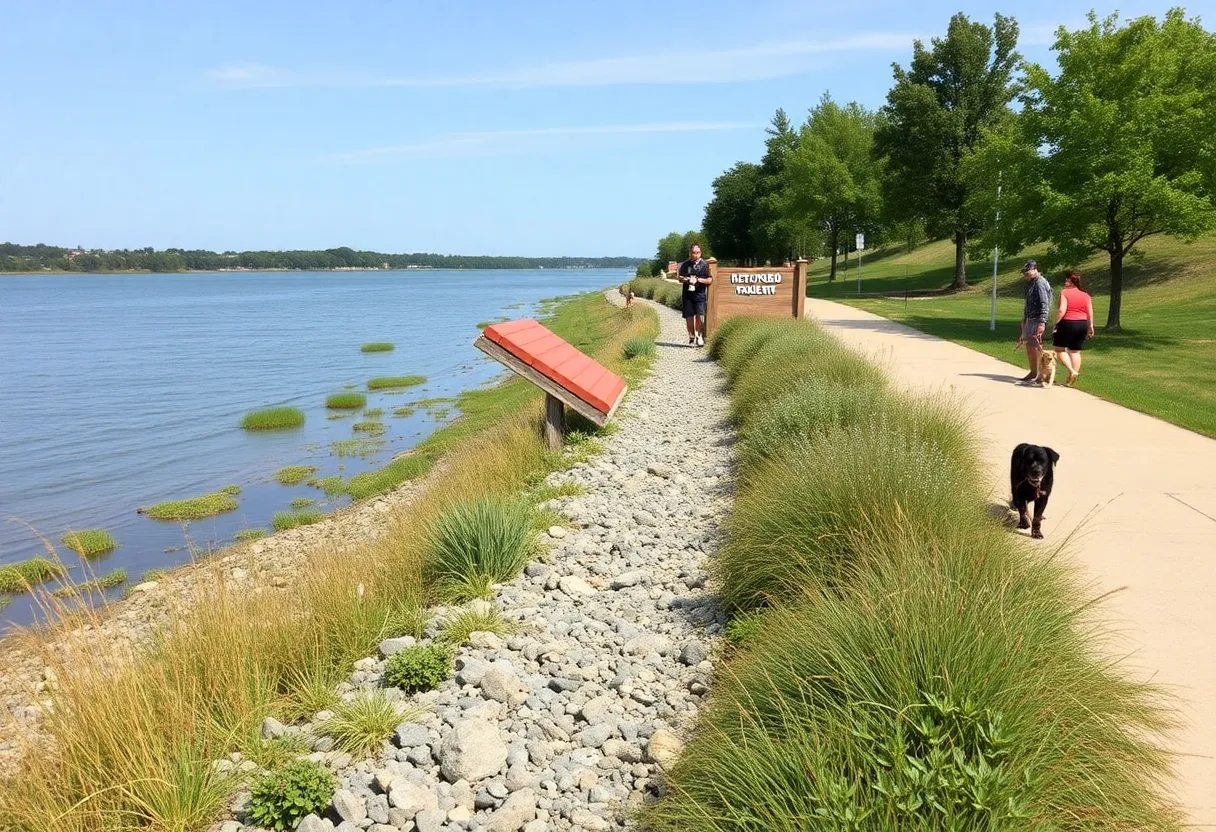Buffalo, NY, October 7, 2025
Buffalo’s Ellicott Island Bark Park has successfully finished a significant shoreline restoration project that focuses on erosion control and enhances local wildlife habitats. The $2 million initiative addresses environmental preservation while improving recreational spaces for the community, especially for dog owners. This restoration aims to protect the park from erosion while creating a safer environment for wildlife and park visitors, ensuring long-term sustainability of this popular recreational area along the Niagara River.
Buffalo, NY: Shoreline Restoration at Ellicott Island Bark Park Completes, Bolstering Erosion Control and Wildlife Habitats
Buffalo’s Ellicott Island Bark Park has completed a major shoreline restoration project on October 7, 2025, marking a significant step forward in environmental protection and community recreation. This initiative, funded by a $2 million grant, directly addresses erosion issues along the Niagara River while creating healthier habitats for local wildlife. The completion enhances the park’s appeal as a safe, accessible space for dog owners and outdoor enthusiasts, ensuring long-term sustainability for this popular recreational area.
The restoration efforts focused on stabilizing the shoreline to prevent further land loss due to water currents and weathering. By implementing natural barriers and native plantings, the project not only curbs erosion but also supports biodiversity in the surrounding ecosystem. Environmental groups have acknowledged the work for its dual role in preserving the Niagara River’s natural balance and encouraging public engagement with nature. This development comes at a time when urban green spaces are increasingly vital for community well-being in Western New York.
Project Details and Environmental Impact
Key components of the restoration included the installation of erosion-control structures, such as riprap and bioengineered slopes, designed to withstand the Niagara River’s dynamic flow. These measures protect the park’s 26 acres of land, which include off-leash areas for dogs, walking trails, and waterfront views. The project also incorporated habitat enhancements, like planting native vegetation to attract pollinators and provide shelter for birds and small mammals. These changes are expected to improve water quality by reducing sediment runoff into the river, benefiting fish populations and overall aquatic health.
The $2 million grant that funded the initiative was allocated specifically for environmental restoration in public parks, highlighting a commitment to blending conservation with recreational use. Construction wrapped up efficiently, minimizing disruptions to park visitors during the process. Now open, the revitalized shoreline offers a more resilient landscape that can handle seasonal floods and rising water levels, a growing concern amid climate variability in the region.
Community and Recreational Benefits
For Buffalo residents, particularly dog owners who frequent Ellicott Island Bark Park, the upgrades mean safer and more enjoyable outdoor experiences. The park, located on the city’s west side near the Niagara River, has long been a hub for pet socialization and exercise. With the new shoreline features, visitors can now enjoy expanded areas for play without the risk of encroaching water damage. The project promotes inclusive access, with pathways designed for easy navigation by families, seniors, and those with mobility aids.
Beyond recreation, the restoration fosters educational opportunities. Local schools and environmental organizations can use the site to demonstrate sustainable land management practices. This aligns with broader efforts in Buffalo to maintain green infrastructure, supporting mental health benefits from nature exposure and encouraging physical activity among residents.
Background on the Initiative and Regional Context
The Ellicott Island Bark Park, established in the early 2000s, has faced ongoing challenges from shoreline erosion due to its riverside location. Prior to this project, sections of the bank had deteriorated, posing safety risks and threatening habitat loss. The restoration addresses these issues head-on, building on previous park improvements like fencing upgrades and waste management systems.
In the larger context of Buffalo’s environmental strategy, this project is part of a series of investments in the Niagara River corridor. The area is ecologically sensitive, serving as a migratory path for birds and a buffer against urban flooding. By prioritizing native species and low-impact designs, the initiative sets a model for similar restorations elsewhere in New York State. It also underscores the role of public funding in preserving urban waterways, which are essential for both ecological integrity and economic vitality through tourism and recreation.
As Buffalo continues to invest in its natural assets, the completion of this restoration reinforces the city’s dedication to sustainable development. The enhanced park not only safeguards the environment but also enriches the daily lives of its community members, ensuring that Ellicott Island Bark Park remains a cherished destination for generations to come.
FAQ
When did the shoreline restoration at Ellicott Island Bark Park conclude?
What improvements does the restoration provide?
How was the project funded?
Who benefits from the enhanced park?
What do environmental groups say about the initiative?
Key Features of the Ellicott Island Bark Park Restoration
| Feature | Description |
|---|---|
| Erosion Control | Stabilization using riprap and bioengineered slopes to prevent land loss along the Niagara River. |
| Wildlife Habitats | Planting native vegetation to support biodiversity, including shelter for birds and pollinators. |
| Recreational Enhancements | Improved off-leash areas and pathways for dog owners and community members. |
| Funding | $2 million grant supporting environmental and public space improvements. |
| Environmental Preservation | Reduced sediment runoff to benefit water quality and Niagara River ecosystems. |




